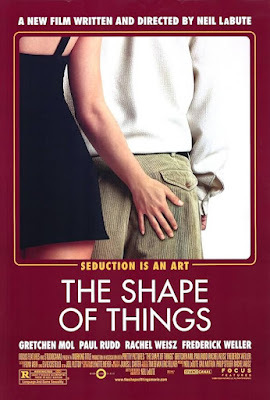Uncovering “The Shape of Things”

Playwright and film directorNeil LaBute is surely not typical of the graduates at Brigham Young University.I know, and like, a number of BYU grads. (We worked together at Osaka’s Expo70, many moons ago.) The former Mormon missionaries with whom I hung out tendedto be trustworthy, smart, and often a lot of fun. But their political andsocial views were on the conservative side, in keeping with the moral tenets ofthe church that shaped their lives.
LaBute, who studied theatreat BYU circa 1980, is something of a different story. His plays, which he hasalso translated to film, lack the basic optimism that I connect with the Churchof Latter Day Saints. La Bute’s style is to zero in on the worst of humanbehavior and follow where it leads. His first big success, which I saw andadmired years ago, was In the Company of Men, a play that became anindie film and picked up several prestigious critics’ awards, It’s a cold-eyedlook at misogyny in the workplace, with two corporate types joining forces tobedevil a hapless female co-worker, with grim results. (To my surprise, I’vejust learned that this corrosive work debuted at BYU in 1992, andsubsequently won an award from the Association for Mormon Letters. So perhapsnot all Mormons are as optimistic about mankind as my former co-workers.)
The film I saw last night,2003’s The Shape of Things, also started out as a LaBute play. Itdebuted in London with a cast made up of Rachel Weisz, Paul Rudd, Gretchen Mol,and Fred Weller. All four also appear in the film version, which is set on andaround a picturesque American collegecampus, played by the California State University branch in ocean-adjacentCamarillo, CA. Though on-screen other students and faculty members come and go,only the four main actors have speaking roles: there’s no question that this isessentially a filmed play, one in which the focus is narrow and talk isall-important.
At first it’s easy for theviewer to get restless while watching a series of mostly two-person dialoguescenes. But the mating-dance aspect of the script is intriguing, and thecharacters are so wildly assorted that we’re curious to see what comes next. Thestory’s Queen Bee, played by the always fascinating Weisz, is am art studentworking on a mysterious graduate thesis project. Convinced that art trumpseverything (including morality), she is adamant in her choices, one of thembeing to bed a nebbishy young man who works—after a fashion—as a guard at thecampus art museum. As played by an initially unrecognizable Paul Rudd, he’s alltoo willing to be molded by this beautiful and outrageous young woman, whohelps him find the self-confidence he has lacked. The main cast is completed byFred Weller, as Rudd’s domineering best friend, and his apparently meekfiancée, the perky blonde Gretchen Moll. There’s a powerful twist ending that Iwouldn’t dream of divulging, but suffice it to say that there’s not a lot ofhappily ever after.
LaBute, who shares with DavidMamet a facility for language as well as a basic pessimism about human nature,makes vivid the cruelty of the characters toward one another. This particularpiece of work also has fun satirizing the art world. LaBute takes on both theprudes of the past (a giant plaster fig-leaf covering the genitalia of an artmuseum statue is key to the story’s beginning) and the hip art-for-art’s-sakeconvictions of the present. If you like witty misanthropy, this one’s for you.
Beverly in Movieland
- Beverly Gray's profile
- 10 followers



